Report by Dick Grosbier for IBS
June 13th to 15th saw a large contingent of IBS Score shooters gather at the Thurmont, Maryland range for the 20th Annual Bud Pryor Memorial Match and Maryland 100/200/300 Score Championships. Randy Jarvais won the Varmint for Score (VFS) Class with an impressive 749-43X performance, while Gary Long took the Hunter Class with a 733-21X Aggregate.
![Bud Pryor Memorial Score Shoot Maryland benchrest championship 100 200 300]()
CLICK HERE for Complete Aggregate Match Results (XLS format)
100 Yard Match Results | 200 Yard Match Results | 300 Yard Match Results
The view downrange in typical Thurmont conditions.
![Bud Pryor Memorial Score Shoot Maryland benchrest championship 100 200 300]()
![Bud Pryor Memorial Score Shoot Maryland benchrest championship 100 200 300]() About the Bud Pryor Memorial Match
About the Bud Pryor Memorial Match
Bud Pryor was a fine gentleman who started shooting IBS matches in 1983. He was a machinest turned gunsmith who made friends and got many people started in shooting IBS registered matches over the next few years. Bud and Dick Grosbier ran the first IBS match at the Thurmont range in April 1983. Click Here to see vintage photos of the 1983 match.
After Bud’s untimely passing a few years later, the club decided to put on a big match and dedicate it to him. As Thurmont is one of the few ranges around with 100/200/300 yard capabilities, we decided to put on a 3-yardage Grand Aggregate match. This was not as simple as it seems, since 100/200/300 was not an IBS-recognized Aggregate. After an agenda item was approved at an IBS winter meeting, 100/200/300 records were set at Thurmont; and, over the years most records have stayed at this range. There are a total of four IBS ranges now holding 100/200/300 yard matches in 2014.
2014 Bud Pryor Day by Day
This year’s match saw generally beautiful weather. For Friday’s 100-yard stage, a 60% chance of rain was forecast and we did have a little rain in the morning but it had minimal effect on the proceedings. Range officer Curtis Nelson wisely delayed the first record match for less than five minutes while a fierce weather front blew through. Other than that, it was a nice day with temps in the mid 80s. Randy Jarvais from Maine started his conquest of the weekend early by taking the lead in the Varmint for Score (VFS) 100-yard stage by turning in a 250-22X score. It should be noted here that well-known competitor Dean Breeden turned in an identical score but Randy’s 5X performance in Match One edged Dean (3X) under Creedmoor rules. Ricky Read was third with 250-20X and Junior Shooter Kevin Donalds Jr. was fourth with 250-19X. There were also some impressive scores in Hunter Class, which is for 10-lb rifles with 2-1/4” forends and max six-power scopes. Last year’s Hunter Class winner Gary Long turned in an excellent 250-15X score followed closely by K.L. Miller with 250-14X and Dean Breeden with 250-13X. It amazes me how these guys shooting 6X scopes turn in scores that will frequently put them in the top half of the VFS class.
On Saturday, the 200-yard matches were held. It was bright and sunny and started out cool in the morning, peaking in the low 80s by mid-afternoon. The wind was extremely challenging and very tricky (I am not just saying this because I personally shot terribly). It was the Randy and Ricky show. By the end of the third match, only four shooters had not dropped points. At the end of the day, only Randy Jarvais and Ricky Read had 250 scores, with 11X and 7X respectively. So in the 100/200 Grand Agg Randy had 500-33X to Ricky’s 500-27X. Both men were well on their way to earning the greatly-coveted IBS 750 stickers. In Hunter class relatively new shooter Charlie Brock took the win with a 245-6X score followed closely by James Lederer with a 244-3X. (James is a new barrel-maker, who currently specializes in 30 caliber barrels for Hunter and VFS classes).
Randy Jarvais, Winner of the VFS Overall Aggregate.
![Bud Pryor Memorial Score Shoot Maryland benchrest championship 100 200 300]()
Sunday dawned bright and beautiful and the targets are moved back another 100 yards to 300. Randy took the lead early with a 4X target on Match One while most of us were struggling to even get 50s. By Match Two Wayne France was chasing at Randy’s heels only one X behind. By the end of Match Three, Roy Hunter was also becoming a threat with a 150-4X score. Roy was shooting his LV 6 PPC with which he won last year’s match. By this point there were only four shooters clean in a field of 32. At the end of Match Four,Tony Seymore, Wayne France, and Randy J. each added 2X to their scores and moved up in the standings. Match Five turned out to be a heart-breaker for Randy. Consider this — if Randy could have shot a 50-1X he would win the 300, win the match, and set two possible new records with a 750-44X total. (Also a 500-22x score in the 200/300 Grand Aggregate would have been a potential record as well.) That could earn Randy 60 Score Shooter of the Year (SSOY) points for winning the match plus 45 points for setting records, giving Randy an unassailable lead in the SSOY race.
But that was not to be. On bull #3 of the final 300-yard target, Randy lost his only shot of the weekend. He suffered what we score shooters call a “Downtown Nine” — a shot that was clearly out of the ten ring even when viewed from the bench. No disputing that one. This moved Randy down to fourth place at 300 yards. Wayne France won the 300-yard VFS with 250-10X. In Hunter class, Orland Bunker, another “Maine-iac”, took top honors with a 240-4X.
But all was not lost for Randy when he dropped the point at 300 yards. Thanks to his consistency and the fact that both Wayne France and Tony Seymore had poor showings at 200 yards, Randy’s 749-43X Grand Agg won the match for him. Ricky Read finished second, with 749-33X. Roy Hunter (6 PPC) was third with 749-27X. In Hunter Class, Gary Long had high score for the weekend, a 733-21X. In second place was Orland Bunker at 733-17X, while Charlie Brock was third with 730-19X.
Match Winners Left to Right: Charlie Brock, Sara Harren, Orland Bunker, Wayne France, Gary Long, Randy Jarvais, Ricky Read, Roy Hunter, Tony Seymore.
![Bud Pryor Memorial Score Shoot Maryland benchrest championship 100 200 300]()
Exhibiting great sportsmanship, Brad Gollner came back Sunday to work with the target crew after shoulder problems forced him to quit shooting Saturday.
![Bud Pryor Memorial Score Shoot Maryland benchrest championship 100 200 300]()
I think everybody had a good time. Event feedback has been very good. I even had one shooter email me and say “My complete drubbing at the Bud Pryor Memorial last weekend notwithstanding, I wish to register for the 200/300 Nationals to be held a Thurmont on July 26 and 27.” As always it was good to see old friends fellow shooters from all over the East. – Dick Grosbier
Great BBQ and Camaraderie
After Saturday’s shooting was complete (and the flags were moved for Sunday’s 300-yard stage), it was time to gather at the clubhouse for the traditional BBQ dinner including pulled Pork sandwiches, cole slaw, potato salad, baked beans and always popular Sara Harren’s cheesy grits. After that we were treated to an amazing assortment of desserts. As usual it was a great time of fellowship and catching up with old friends some not seen since last year’s Bud Pryor Memorial. We had contestants from as far away as Maine, Wisconsin, and South Carolina.
![Bud Pryor Memorial Score Shoot Maryland benchrest championship 100 200 300]()
Share the post "IBS Report: Bud Pryor Memorial Shoot & Maryland 100/200/300"





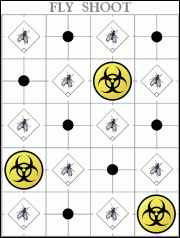










 .009″ — The Record That Stood for 40 Years.
.009″ — The Record That Stood for 40 Years.




 The Light Varmint 100-yard stage looked to be all Harley Baker, one of the newest inductees into the U.S. Benchrest Hall of Fame. Harley arrives at any match with impeccably prepared equipment tuned to a knife’s edge. He is tough to beat at any range. He was cruising to yet another Agg win, with Smiley Hensley pretty far behind. To finish off with a flourish, Harley nailed a very nice .190 on his last target.
The Light Varmint 100-yard stage looked to be all Harley Baker, one of the newest inductees into the U.S. Benchrest Hall of Fame. Harley arrives at any match with impeccably prepared equipment tuned to a knife’s edge. He is tough to beat at any range. He was cruising to yet another Agg win, with Smiley Hensley pretty far behind. To finish off with a flourish, Harley nailed a very nice .190 on his last target.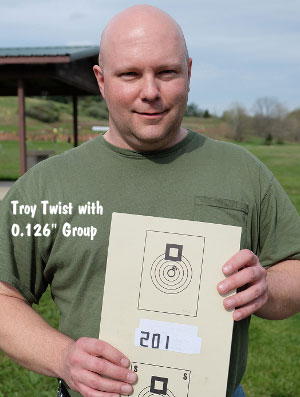


 Two-Gun Top 3: Kent Harshman (Third), Harley Baker (Winner), Jeff Stover (Second).
Two-Gun Top 3: Kent Harshman (Third), Harley Baker (Winner), Jeff Stover (Second).


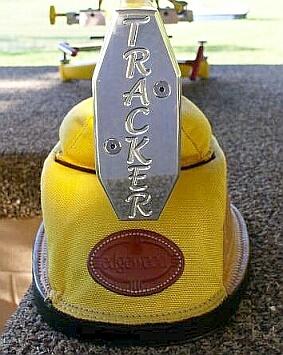 1. Align Front Rest and Rear Bags. We see many shooters whose rear bag is angled left or right relative to the bore axis. This can happen when you rush your set-up. But even if you set the gun up carefully, the rear bag can twist due to recoil or the way your arm contacts the bag. After every shot, make sure your rear bag is aligned properly (this is especially important for bag squeezers who may actually pull the bag out of alignment as they squeeze).
1. Align Front Rest and Rear Bags. We see many shooters whose rear bag is angled left or right relative to the bore axis. This can happen when you rush your set-up. But even if you set the gun up carefully, the rear bag can twist due to recoil or the way your arm contacts the bag. After every shot, make sure your rear bag is aligned properly (this is especially important for bag squeezers who may actually pull the bag out of alignment as they squeeze). 3. Weigh Your Charges — Every One. This may sound obvious, but many folks still rely on a powder measure. Yes we know that most short-range BR shooters throw their charges without weighing, but if you’re going to pre-load for a club match there is no reason NOT to weigh your charges. You may be surprised at how inconsistent your powder measure actually is. One of our testers was recently throwing H4198 charges from a Harrell’s measure for his 30BR. Each charge was then weighed twice with a Denver Instrument lab scale. Our tester found that thrown charges varied by up to 0.7 grains! And that’s with a premium measure.
3. Weigh Your Charges — Every One. This may sound obvious, but many folks still rely on a powder measure. Yes we know that most short-range BR shooters throw their charges without weighing, but if you’re going to pre-load for a club match there is no reason NOT to weigh your charges. You may be surprised at how inconsistent your powder measure actually is. One of our testers was recently throwing H4198 charges from a Harrell’s measure for his 30BR. Each charge was then weighed twice with a Denver Instrument lab scale. Our tester found that thrown charges varied by up to 0.7 grains! And that’s with a premium measure. 5. Check Your Fasteners. Before a match you need to double-check your scope rings or iron sight mounts to ensure everything is tight. Likewise, you should check the tension on the screws/bolts that hold the action in place. Even on a low-recoiling rimfire rifle, action screws or scope rings can come loose during normal firing.
5. Check Your Fasteners. Before a match you need to double-check your scope rings or iron sight mounts to ensure everything is tight. Likewise, you should check the tension on the screws/bolts that hold the action in place. Even on a low-recoiling rimfire rifle, action screws or scope rings can come loose during normal firing.
 The Whidden
The Whidden 
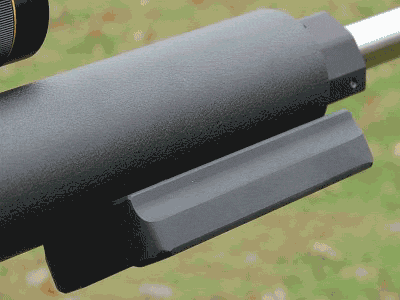

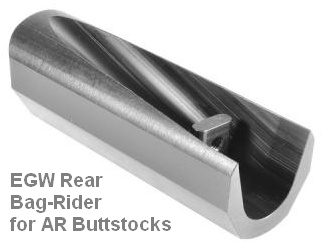
 Texan Mike Bryant is a superb gunsmith and a very successful benchrest competitor. And though he is getting up in years, he hasn’t lost any of his talent as a trigger-puller. In fact, if recent results are any indication, Mike Bryant isn’t getting older, he’s getting better.
Texan Mike Bryant is a superb gunsmith and a very successful benchrest competitor. And though he is getting up in years, he hasn’t lost any of his talent as a trigger-puller. In fact, if recent results are any indication, Mike Bryant isn’t getting older, he’s getting better.
 “I owe a lot of what I was able to accomplish with this Agg to Gene Bukys. Gene is currently one of the hottest-shooting benchrest competitors in the United States, and a member of the Benchrest Hall of Fame. After the Cactus Classic this year, Gene shared with us the make, twist rate, and contour of the barrels that he had been using to win everything in sight. He also told me which of his reamers that Dave Kiff had made him that he had been using and which one to order from Kiff to shoot the same chamber.”
“I owe a lot of what I was able to accomplish with this Agg to Gene Bukys. Gene is currently one of the hottest-shooting benchrest competitors in the United States, and a member of the Benchrest Hall of Fame. After the Cactus Classic this year, Gene shared with us the make, twist rate, and contour of the barrels that he had been using to win everything in sight. He also told me which of his reamers that Dave Kiff had made him that he had been using and which one to order from Kiff to shoot the same chamber.”
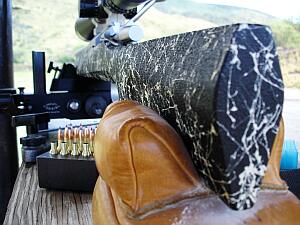 Back in the old days, about the time Fred Flintstone was still alive, I worked for Pat McMillan for free, from time to time to learn all his secrets. One day little Speedy was filling some new sand bags out behind Pat’s shop, stuffing them with more sand than Taco Bell put beans in their Burritos. When Pat stepped out the back door and inquired as to what in the hell was I doing packing them there bags the way I was.
Back in the old days, about the time Fred Flintstone was still alive, I worked for Pat McMillan for free, from time to time to learn all his secrets. One day little Speedy was filling some new sand bags out behind Pat’s shop, stuffing them with more sand than Taco Bell put beans in their Burritos. When Pat stepped out the back door and inquired as to what in the hell was I doing packing them there bags the way I was. 
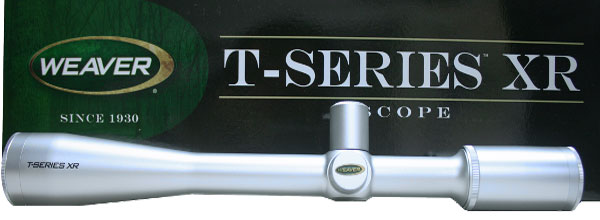
 We have looked through the new Weaver 46X scope and it is very sharp. Brightness is good — it seems comparable with a Leupold 45x45mm Competition (but that was on a bright, sunny day). Initial tests show the clicks to be tactile and positive, but we haven’t had a chance to do a full “box test” to confirm tracking. Weaver claims the new XR series scopes will focus down to 50 feet, but with the 46X we had some questions about its extreme close-focus capability. If you’re shooting beyond 50 yards, the focus should be fine.
We have looked through the new Weaver 46X scope and it is very sharp. Brightness is good — it seems comparable with a Leupold 45x45mm Competition (but that was on a bright, sunny day). Initial tests show the clicks to be tactile and positive, but we haven’t had a chance to do a full “box test” to confirm tracking. Weaver claims the new XR series scopes will focus down to 50 feet, but with the 46X we had some questions about its extreme close-focus capability. If you’re shooting beyond 50 yards, the focus should be fine.
 New 24X and 36X T-Series XR Scopes with Side-Focus and 1″ Tubes
New 24X and 36X T-Series XR Scopes with Side-Focus and 1″ Tubes
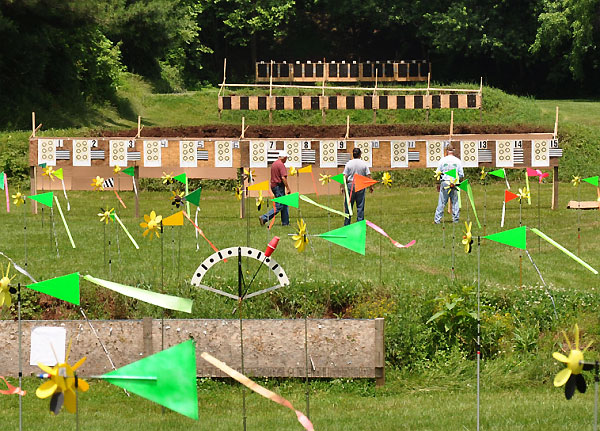
 About the Bud Pryor Memorial Match
About the Bud Pryor Memorial Match











 Smooth. Efficient. Well-run. Lots of small groups. Those words pretty much spell out the 45th annual
Smooth. Efficient. Well-run. Lots of small groups. Those words pretty much spell out the 45th annual 





 We know that many of our readers have never seen a “Hammerhead” benchrest stock before. This is a design with an extra wide section in the very front, tapering to a narrow width starting about 6″ back. When paired with a super-wide front sandbag, the hammerhead design provides added stability — just like having a wider track on a racing car. Some folks think mid-range and long-range benchrest stocks can only be 3″ wide. Not so — IBS and NBRSA rules now allow much wider fore-ends. While F-Class Open rules limit fore-end width to 3″ max, there is not such restriction on IBS or NBRSA Light Guns or Heavy Guns for 600- and 1000-yard competition. Here’s a 5″-wide Hammerhead design from
We know that many of our readers have never seen a “Hammerhead” benchrest stock before. This is a design with an extra wide section in the very front, tapering to a narrow width starting about 6″ back. When paired with a super-wide front sandbag, the hammerhead design provides added stability — just like having a wider track on a racing car. Some folks think mid-range and long-range benchrest stocks can only be 3″ wide. Not so — IBS and NBRSA rules now allow much wider fore-ends. While F-Class Open rules limit fore-end width to 3″ max, there is not such restriction on IBS or NBRSA Light Guns or Heavy Guns for 600- and 1000-yard competition. Here’s a 5″-wide Hammerhead design from 







